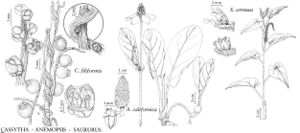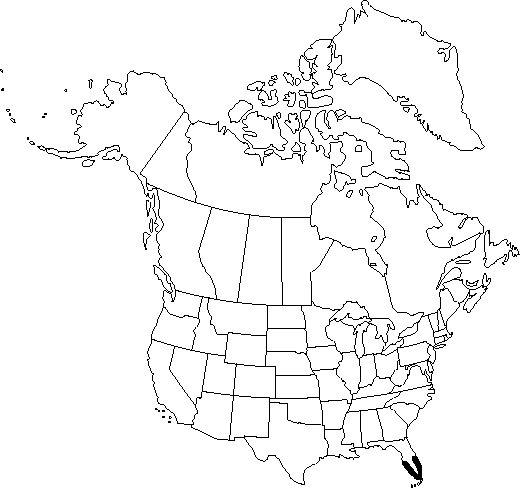Difference between revisions of "Cassytha filiformis"
Sp. Pl. 1: 35. 1753.
Common names: Love-vine
EndemicSelected by author to be illustrated
Treatment appears in FNA Volume 3.
FNA>Volume Importer |
FNA>Volume Importer |
||
| Line 24: | Line 24: | ||
}}<!-- | }}<!-- | ||
| − | --><span class="statement" id="st- | + | --><span class="statement" id="st-undefined" data-properties=""><b>Stems </b>twining, pale green to yellow-green to orange, filiform, glabrous or pubescent. <b>Leaves</b> alternate, ca. 1 mm. <b>Inflorescences</b> spikes, rarely reduced to single flower. <b>Flowers</b> bisexual, subtended by ciliate bract and bracteoles; outer 3 tepals 0.1-1 mm, similar to bracteoles, inner 3 tepals 1-1.8 mm, apex incurved; pistil 1.2 mm, glabrous. <b>Drupe</b> to 7 mm diam. <b>2n</b> = 48.</span><!-- |
-->{{Treatment/Body | -->{{Treatment/Body | ||
| Line 55: | Line 55: | ||
|publication year=1753 | |publication year=1753 | ||
|special status=Endemic;Selected by author to be illustrated | |special status=Endemic;Selected by author to be illustrated | ||
| − | |source xml=https://jpend@bitbucket.org/aafc-mbb/fna- | + | |source xml=https://jpend@bitbucket.org/aafc-mbb/fna-data-curation.git/src/9216fc802291cd3df363fd52122300479582ede7/coarse_grained_fna_xml/V3/V3_563.xml |
|genus=Cassytha | |genus=Cassytha | ||
|species=Cassytha filiformis | |species=Cassytha filiformis | ||
| − | |||
| − | |||
| − | |||
| − | |||
| − | |||
| − | |||
| − | |||
| − | |||
| − | |||
| − | |||
| − | |||
| − | |||
| − | |||
| − | |||
| − | |||
| − | |||
| − | |||
| − | |||
| − | |||
| − | |||
}}<!-- | }}<!-- | ||
-->[[Category:Treatment]][[Category:Cassytha]] | -->[[Category:Treatment]][[Category:Cassytha]] | ||
Revision as of 13:43, 27 July 2019
Stems twining, pale green to yellow-green to orange, filiform, glabrous or pubescent. Leaves alternate, ca. 1 mm. Inflorescences spikes, rarely reduced to single flower. Flowers bisexual, subtended by ciliate bract and bracteoles; outer 3 tepals 0.1-1 mm, similar to bracteoles, inner 3 tepals 1-1.8 mm, apex incurved; pistil 1.2 mm, glabrous. Drupe to 7 mm diam. 2n = 48.
Phenology: Flowering spring–summer (May–Jul).
Habitat: Coastal vegetation
Elevation: 0-20 m
Discussion
Cassytha filiformis is a very distinctive plant that can be confused only with Cuscuta, a vining parasite of the Cuscutaceae.
Selected References
None.
Lower Taxa
None.

